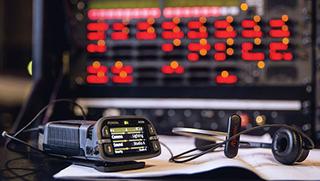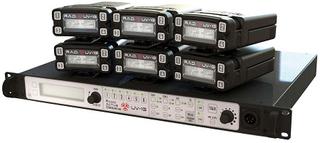Bands on the Run
SEATTLE—The broadcast incentive auctions closed at the end of March were predominately covered in the business press, with the repurposing 84 MHz of spectrum producing $19.8 billion in revenue, with more than $7 billion going into the U.S. Treasury.
On the operational end of broadcasting, however, is that as the 600 MHz auction-winning wireless carriers begin to utilize the spectrum they’ve bought, broadcasters and other intercom and wireless mic users who have long used that UHF band will have to find other solutions.
Fortunately, this hasn’t exactly snuck up on the intercom system makers. They offer an array of solutions.

Riedel’s Bolero wireless intercoms use the DECT frequency.
ALL DECT IN
One option has been to work in DECT (Digital Enhanced Cordless Telecommunications). The most common DECT frequencies are between 1880–1900 MHz, and the spectrum is unlicensed and technology exclusive.
“Our plan all along was to remain with the DECT frequencies,” said Joe Commare, marketing and sales at Riedel Communications. Two years ago the company began working on a new product line, Bolero, to optimize DECT performance.
Key to that effort has been use of the DV36 codec, a high-clarity 7 KHz audio bandwidth with low latency. And where previously “you [could] have four, maybe five beltpacks per antenna… we’re able to get up to 10 beltpacks per antenna.” A second advantage to use of that new codec is beltpack battery life. “We’re getting 15, 16 hours to a battery charge as well, a great factor when these things are being used all day on a gig,” Commare said.
Get the TV Tech Newsletter
The professional video industry's #1 source for news, trends and product and tech information. Sign up below.
Another company that went for the DECT solution as well as the 2.4 GHz ISM (Industrial, Scientific and Medical) band is Clear-Com. “We have discontinued our UHF products,” said Craig Frederickson, manager for wireless services for Clear-Com. “We saw this coming many years ago.”

Clear-Com’s FreeSpeak II wireless intercom system
Two advantages the analog UHF systems had were low latency and transmission distance. In attacking the latency issue, the company’s FreeSpeak II wireless system boasts latency below 60 milliseconds (ms). To mitigate a lower transmission distance, the company, “created the first cellular roaming system.
“This allows you to put up antennas like a cellular system, which allows you to create coverages in your buildings,” Frederickson said.
Frederickson pointed to another advantage in its digital FreeSpeak II system: matrix technology. “I can have up to five channels on a beltpack now.”
CHANGING FREQUENCIES
Pliant Technologies is introducing a new wireless intercom product line, CrewCom, that not only operates on both the 2.4 GHz and 900 MHz bands, but also has a proprietary architecture “that will allow us to add additional frequency bands for the future, as we see appropriate,” said Gary Rosen, global sales manager for Pliant Technologies.
“The added frequencies will be in addition and compatible with the current system. With most traditional RF systems, when you need to change frequencies you have to toss out your entire system and start over.”
In addition to this architecture, Crew- Com also uses frequency hopping, spread spectrum (FHSS) technology, where “we change frequencies every 10 ms,” and transmit the full data signal twice on two different frequencies. “When you think about interference in the RF spectrum, it’s often in one area,” Rosen said. This technique helps avoid signal loss due to RF interference.

Radio Active Designs’ UV-1G intercom uses the VHF band for analog wireless communications.
AEQ has attacked the need for wireless intercom operation by using Wi-Fi technology to connect its Xplorer beltpacks. The company’s Xvirtual a software application runs on iOS or Windows, and operates as a single, fully featured, intercom.
“The owner of the studio controls the Wi-Fi router,” said Juan Carlos Ortolan, CEO of OM Solutions, which works with AEQ in the U.S. “The router assigns an IP address to each of the Xplorer beltpacks.” When a Wi-Fi beltpack leaves the coverage area of an access point and enters the adjacent, a roaming process is initiated that is controlled by the Wi-Fi manager through both access points.
As for working outside the studio, Ortolan said AEQ has been researching JVC’s mesh network, which can be built into an OB van. “When the OB van arrives on location, it would deploy a strong mesh that would handle all of the video, communications and so on,” he said.
DON’T FORGET VHF
One company, Radio Active Design, has targeted the Channels 7–13 on the VHF band for analog wireless intercom use.
“VHF survived the auction,” said James Stoffo, Radio Active Design CTO. “We’re using amplitude modulation instead of frequency modulation, and our beltpacks are so narrow band that we can fit about 200 beltpacks in pretty much any given city going forward.”
Stoffo explained the advantage of analog operation for events that require frequency coordination: “All of the other coms that are out there, they’re either spread spectrum or frequency hopping, or DECT, and those are not coordinate-able.” He also noted that those digital systems provide “propagation that’s much less favorable because the frequencies are so high—at 1.9 GHz or 2.4 GHz—that your range is generally not adequate for a large sporting event.”
So as the frequencies that wireless intercom users have long counted on are sold off to well-heeled wireless behemoths, intercom designers are offering an array of plans to migrate to new remaining RF bands.
